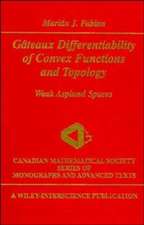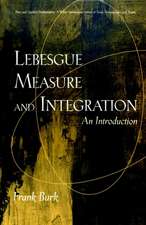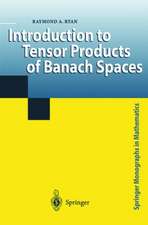The Mathematical Legacy of Srinivasa Ramanujan
Autor M. Ram Murty, V. Kumar Murtyen Limba Engleză Hardback – 6 oct 2012
| Toate formatele și edițiile | Preț | Express |
|---|---|---|
| Paperback (1) | 885.49 lei 6-8 săpt. | |
| Springer India – 9 noi 2014 | 885.49 lei 6-8 săpt. | |
| Hardback (1) | 891.33 lei 6-8 săpt. | |
| Springer India – 6 oct 2012 | 891.33 lei 6-8 săpt. |
Preț: 891.33 lei
Preț vechi: 1086.99 lei
-18% Nou
Puncte Express: 1337
Preț estimativ în valută:
170.56€ • 178.52$ • 141.96£
170.56€ • 178.52$ • 141.96£
Carte tipărită la comandă
Livrare economică 01-15 aprilie
Preluare comenzi: 021 569.72.76
Specificații
ISBN-13: 9788132207696
ISBN-10: 8132207696
Pagini: 200
Ilustrații: XII, 188 p.
Dimensiuni: 155 x 235 x 17 mm
Greutate: 0.45 kg
Ediția:2013
Editura: Springer India
Colecția Springer
Locul publicării:New Delhi, India
ISBN-10: 8132207696
Pagini: 200
Ilustrații: XII, 188 p.
Dimensiuni: 155 x 235 x 17 mm
Greutate: 0.45 kg
Ediția:2013
Editura: Springer India
Colecția Springer
Locul publicării:New Delhi, India
Public țintă
ResearchCuprins
Preface.- Chapter 1. The Legacy of Srinivasa Ramanujan.- Chapter 2. The Ramanujan tau function.- Chapter 3. Ramanujan’s conjecture and l-adic representations.- Chapter 4. The Ramanujan conjecture from GL(2) to GL(n).- Chapter 5. The circle method.- Chapter 6. Ramanujan and transcendence.- Chapter 7. Arithmetic of the partition function.- Chapter 8. Some nonlinear identities for divisor functions.- Chapter 9. Mock theta functions and mock modular forms.- Chapter 10. Prime numbers and highly composite numbers.- Chapter 11. Probabilistic number theory.- Chapter 12. The Sato-Tate conjecture for the Ramanujan tau-function.- Bibliography.- Index.
Recenzii
“This book is based on a number of talks the authors gave at various research institutes. Their aim is to survey some of Srinivasa Ramanujan’s most significant achievements and the developments they have led to over the last decades. … This volume is suitable as a first introduction to some of Ramanujan’s remarkable and deep ideas.” (C. Baxa, Monatshefte für Mathematik, Vo. 180, 2016)
“The authors introduce the reader to the topics through a historical account of the origin and later developments. … We warmly recommend this book for those who would like to have a glimpse on Ramanujan’s mathematics. Without being lost in the technicalities the reader will get a good look at the shape of many central questions.” (Péter Hajnal, Acta Scientiarum Mathematicarum (Szeged), Vol. 80 (1-2), 2014)
“The Murtys’ goal … is to present Ramanujan’s mathematical legacy to a broad audience, and the thrust of the book is a set of eleven chapters discussing exactly that. … the book will utterly charm you, given its accessibility, style, structure, and depth. It’s a great pleasure to read, and it’s fine scholarship.” (Michael Berg, MAA Reviews, December, 2013)
“This book is an outcome of lectures given by both authors in the last quarter century on various aspects of Ramanujan’s work at research institutions in India and Canada, to audiences ranging from graduate students to senior researchers. Thus the book is written in a style that will appeal to both research mathematicians and students desiring to enter the exciting world of Ramanujan’s mathematics. … the exposition is good and the book will be of interest to students and researchers … .” (Krishnaswami Alladi, Mathematical Reviews, September, 2013)
“The authors introduce the reader to the topics through a historical account of the origin and later developments. … We warmly recommend this book for those who would like to have a glimpse on Ramanujan’s mathematics. Without being lost in the technicalities the reader will get a good look at the shape of many central questions.” (Péter Hajnal, Acta Scientiarum Mathematicarum (Szeged), Vol. 80 (1-2), 2014)
“The Murtys’ goal … is to present Ramanujan’s mathematical legacy to a broad audience, and the thrust of the book is a set of eleven chapters discussing exactly that. … the book will utterly charm you, given its accessibility, style, structure, and depth. It’s a great pleasure to read, and it’s fine scholarship.” (Michael Berg, MAA Reviews, December, 2013)
“This book is an outcome of lectures given by both authors in the last quarter century on various aspects of Ramanujan’s work at research institutions in India and Canada, to audiences ranging from graduate students to senior researchers. Thus the book is written in a style that will appeal to both research mathematicians and students desiring to enter the exciting world of Ramanujan’s mathematics. … the exposition is good and the book will be of interest to students and researchers … .” (Krishnaswami Alladi, Mathematical Reviews, September, 2013)
Notă biografică
M. Ram Murty is head of the Department of Mathematics and Statistics at Queen's University, and is a Queen's research chair in mathematics. He is also professor of philosophy at Queen's. He was elected a fellow of the Royal Society of Canada in 1990, the Indian National Science Academy in 2008, and won the Coxeter–James Prize, Jeffery–Williams Prize, E.W.R. Steacie Fellowship, and the Killam Fellowship. His research areas include number theory, modular forms, elliptic curves, and sieve theory. His book Non-vanishing of L-functions and Applications, coauthored by his brother V. Kumar Murty, won the 1996 Balaguer Prize and was published by Birkhauser. In addition, Ram is adjunct professor at McGill University; TIFR; IMSc; CMI; IIT Bombay; IISER, West Bengal; Vivekananda University; and Harish Chandra Research Institute, Uttar Pradesh.
V. Kumar Murty is head of the Department of Mathematics at the University of Toronto. His research areas include number theory, arithmetic geometry, and their applications. He was awarded the Coxeter-James Prize of the Canadian Mathematical Society in 1991, the E. W. R. Steacie Fellowship of NSERC in 1995, and the Inventor of the Year Award of the University of Toronto in 2011. He was elected a fellow of the Royal Society of Canada in 1995 and a fellow of the National Academy of Sciences in 2011. He served as editor-in-chief of the Journal of the Ramanujan Mathematical Society, and as editor of the Transactions of the American Mathematical Society. Moreover, he served on the board of directors of the Canadian Mathematical Society during 1995–1999 and as vice-president of the society during 2009–2011. Kumar Murty received his PhD from Harvard University. He is adjunct professor at TIFR, IMSc, CMI, the Harish-Chandra Research Institute, and Vivekananda University.
V. Kumar Murty is head of the Department of Mathematics at the University of Toronto. His research areas include number theory, arithmetic geometry, and their applications. He was awarded the Coxeter-James Prize of the Canadian Mathematical Society in 1991, the E. W. R. Steacie Fellowship of NSERC in 1995, and the Inventor of the Year Award of the University of Toronto in 2011. He was elected a fellow of the Royal Society of Canada in 1995 and a fellow of the National Academy of Sciences in 2011. He served as editor-in-chief of the Journal of the Ramanujan Mathematical Society, and as editor of the Transactions of the American Mathematical Society. Moreover, he served on the board of directors of the Canadian Mathematical Society during 1995–1999 and as vice-president of the society during 2009–2011. Kumar Murty received his PhD from Harvard University. He is adjunct professor at TIFR, IMSc, CMI, the Harish-Chandra Research Institute, and Vivekananda University.
Textul de pe ultima copertă
Srinivasa Ramanujan was a mathematician brilliant beyond compare. There is extensive literature available on the work of Ramanujan, but what is more difficult to find in the literature is an analysis that would place his mathematics in context and interpret it in terms of modern developments. The 12 lectures by G. H. Hardy, delivered in 1936, served this purpose at the time they were given. This book presents Ramanujan’s essential mathematical contributions and gives an informal account of some of the major developments that emanated from his work in the 20th and 21st centuries. It contends that his work is still having an impact on many different fields of mathematical research. The book examines some of these themes in the landscape of 21st-century mathematics. These essays, based on the lectures given by the authors, focus on a subset of Ramanujan’s significant papers and show how these papers shaped the course of modern mathematics.
Caracteristici
Gives a panoramic view of the main contributions of Srinivasa Ramanujan Presents a major theme of Ramanujan's work in non-technical language Provides an excellent introduction to Ramanujan's life and work Includes supplementary material: sn.pub/extras














